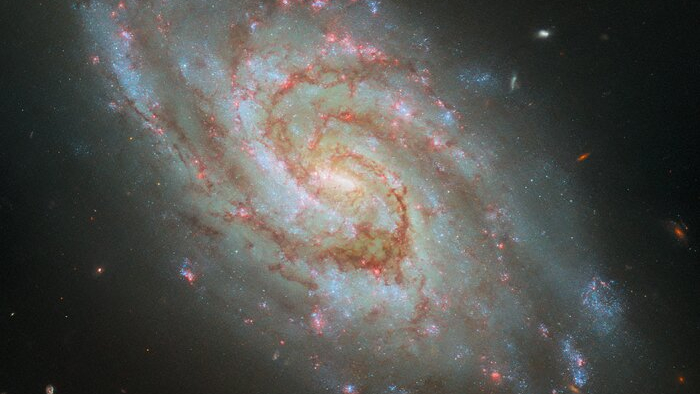Hubble Space Telescope spies a spiral galaxy in a cosmic 'clock'
Seen on a diagonal tilt, the galaxy appears to be swinging like a pendulum through space.

A dazzling new image from the Hubble Space Telescope captures a bright spiral galaxy on a diagonal tilt, resembling a pendulum swinging back and forth through space.
The galaxy, called IC 1954, is located approximately 45 million light-years from Earth in the constellation Horologium, The Clock. It boasts a bright central bar and two large, winding spiral arms threaded with dark clouds of dust and speckled with blue and pink glowing patches.
Recent observations of IC 1954 offer improved views of the galaxy's star-forming regions compared to earlier Hubble images released in 2021. The new image includes H-alpha data, represented by the bright red areas where hydrogen is present, feeding new stars.
"The improved coverage of star-forming nebulas, which are prominent emitters of the red H-alpha light, can be seen in the numerous glowing, pink spots across the disc of the galaxy," European Space Agency (ESA) officials said in a statement releasing the new image. "Interestingly, some astronomers posit that the galaxy’s 'bar' is actually an energetic star-forming region that just happens to lie over the galactic center."
Related: The best Hubble Space Telescope images of all time!
The new image combines data from the Hubble Space Telescope, the James Webb Space Telescope and the ground-based Atacama Large Millimeter/submillimeter Array in Chile. In addition to IC 1954, the telescopes are jointly surveying over fifty other nearby galaxies in radio, infrared, optical and ultraviolet light. The combined efforts of the telescopes allows astronomers to better understand the path matter takes through stars and the interstellar gas and dust in each galaxy, according to the statement.
"Hubble's observing capabilities form an important part of this survey: it can capture younger stars and star clusters when they are brightest at ultraviolet and optical wavelengths, and its H-alpha filter effectively tracks emission from nebulas," ESA officials said. "The resulting dataset will form a treasure trove of research on the evolution of stars in galaxies, which Webb will build upon as it continues its science operations into the future."
Breaking space news, the latest updates on rocket launches, skywatching events and more!

Samantha Mathewson joined Space.com as an intern in the summer of 2016. She received a B.A. in Journalism and Environmental Science at the University of New Haven, in Connecticut. Previously, her work has been published in Nature World News. When not writing or reading about science, Samantha enjoys traveling to new places and taking photos! You can follow her on Twitter @Sam_Ashley13.
